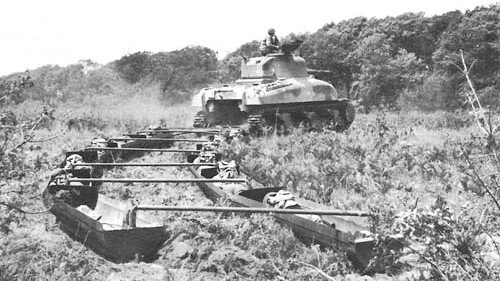

Italy, the spring of 1944. The American 5th Army had invaded months earlier, but found itself stuck in a stalemate against Italian and German forces in the winter months. A breakout was needed, and at Anzio the Americans were looking for ways to decisively attack and overcome Axis resistance.
One solution: sleds. Battle sleds.
Brig. Gen. John W. O’Daniel, commander of the 3rd Division, had an idea. Why not have tanks pull soldiers over mine-filled areas, with the added benefit of helping to conceal Allied numbers? He devised a proposal for 12 sleds, linked together, to be pulled by a single tank. Each bed would be made out of half of a torpedo shell. O’Daniel’s staff expanded on that, adding runners to reduce friction. Over the course of two weeks, the 5th Army created 360 sleds for use in combat. According to Lida Mayo’s book ‘The Ordnance Department: On Beachhead and Battlefront,’ they were constructed under a large circus tent.
“Towed by tanks, 12 at a time, they brought combat squads invisibly to the front lines. Wherever a tank could smash its way through, the infantry could follow in their sleds,” one World War II-era newsreel said at time, calling the concept the “modern equivalent of the Trojan Horse.”

In some ways, there’s logic behind the concept. Being carried this way keeps soldiers low, making them hard targets for enemies to hit. They can be spread out, rather than hiding behind tanks for cover. Depending on the opposition’s field of vision, the Army could hide some of its forces and surprise enemies with greater than expected numbers.
Then there are the flaws in the plan. For one, terrain. The sleds needed relatively smooth, unbroken ground to travel over without being caught. Rocky fields or dug up trenches could snag them, even if a tank could make it through. If the enemy had the high ground, soldiers in the sleds were easy targets. And because the sleds were pulled by the tanks, they faced the same challenges as tanks. Mines were a major risk; even if antipersonnel mines could be avoided, if a tank was disabled by an anti-tank mine, that left soldiers suddenly stuck mid-transit.
In combat in the Battle of Anzio in May, they had mixed results. According to Mayo, ‘[t]he worst impediments were ditches and mines that immobilized the tanks. In one regiment a platoon of tanks and four sets of sleds failed to get into action because of rough ground and the loss of several tanks from mines; in another, the results were negligible because the terrain was unsuitable; in a third unit, the towed infantry, supported by the tanks, took a strongly fortified house. Infantrymen were not enthusiastic about the sleds because they felt like “dead ducks” lying so close behind the tanks.’
The Battle of Anzio was an Allied victory, albeit a bloody one. It saw more than 40,000 American casualties, nearly a third of the total force assembled for the breakout. But, the Americans pushed through and captured Rome in early June. O’Daniel found the sled’s overall effectiveness to be uneven and didn’t push forward with them as a tactic. Some of the devices that were developed for Italy saw action in one more campaign, when the Allies pushed into southern France.
Subscribe to Task & Purpose Today. Get the latest military news and culture in your inbox daily.
The U.S. Army wasn’t alone in using battle sleds. O’Daniel wasn’t the inventor either. Other nations in the 1930s and 1940s tried them. The Soviet Red Army utilized cruder versions during the Winter War, with the thick layer of snow in Finland making them useful transports. The Nazis also tried a version; instead of single-person occupancy beds, these were more like tank-drawn carriages.
But with World War II over, the United States Army decided not to stick with battle sleds. Instead the Army focused on armored personnel carriers, which could provide better protection, offensive capabilities and were less impeded by terrain the way sleds were. Cold War technical innovation focused more on bigger, high-tech elements like jet fighters or nuclear weapons systems than improvised infantry tactics. But, the humble, flawed battle sled went out with a mixed record.
The latest on Task & Purpose
- Four Marines trained an Air Force base to take the Marine Corps fitness test. The Air Force gave them medals for it.
- Sailor proudly rocks ‘E-4 Mafia’ patch as he stands watch on USS Abraham Lincoln
- The A-10 era is over for this legendary Air Force attack squadron
- A comprehensive guide to the shoulder tabs Army soldiers wear on their uniforms
- 101st Airborne Division troops headed to Middle East, 3rd Infantry will go to Europe
